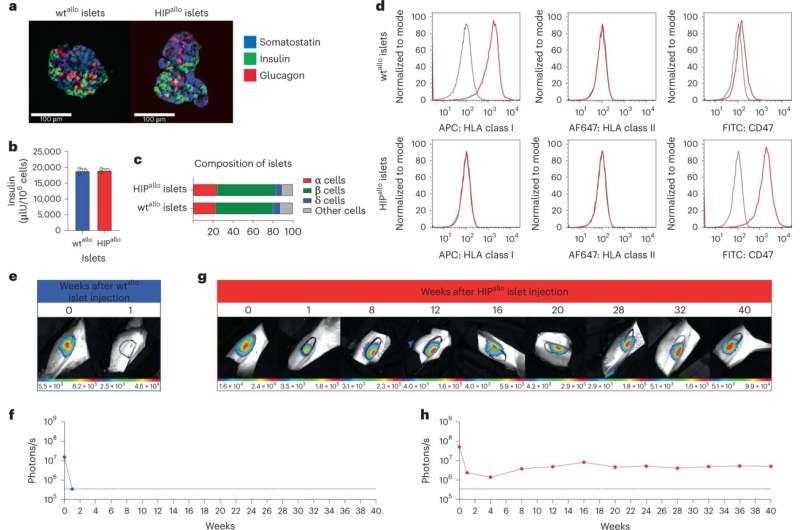May 10, 2023 report
This article has been reviewed according to Science X's editorial process and policies. Editors have highlighted the following attributes while ensuring the content's credibility:
fact-checked
peer-reviewed publication
trusted source
proofread
Breakthrough research could bring stem cell therapy to the masses

Researchers at Sana Biotechnology, Inc., in California, have made a significant breakthrough in realizing the promise of stem cell therapy: stem cells that do not trigger an immune response from an immunologically incompatible donor.
In the paper "Hypoimmune induced pluripotent stem cells survive long term in fully immunocompetent, allogeneic rhesus macaques," published in Nature Biotechnology, the researchers detail how they cloaked a line of hypoimmune pluripotent (HIP) stem cells to evade the normal rejection and destruction obstacles to therapeutic use.
In an experimental setting, hypoimmune pluripotent cells did not trigger an immune cell response. They were also impervious to cytotoxicity incited by wild-type stem cells transplanted along with them, successfully evading direct detection and effects from the enrichment of untargeted threats.
The HIP cells survived unrestricted for 16 weeks (the entire test duration) in fully immunocompetent allogeneic recipients and differentiated into several lineages, whereas wild-type cells were vigorously rejected.
In a humanized diabetic mouse model, pancreatic differentiated human HIP cells lasted four weeks and showed evidence of improving the condition. The mice were not immunosuppressed and were not a type match for the cell types used.
An additional long-term test of HIP cells found cell islets 40 weeks after implantation in rhesus macaque recipients without immunosuppression, compared to an unedited wild-type version that was destroyed within a week.
Stem cells have the potential to revolutionize medicine as they can be manipulated to differentiate into various cell types, making them a promising source of new cells for transplantation or regenerative medicine. By introducing stem cells to damaged tissue or organs, it may be possible to regenerate healthy tissue and restore proper function. This has implications for developing new therapies for various diseases, including cancer, heart disease, and neurological disorders.
Human induced pluripotent stem cells (hiPSCs) were first created in 2007 by Kazutoshi Takahashi and colleagues at Kyoto University in Japan. Since then, researchers have been working to find ways of unlocking the potential of these stem cells for therapeutic applications, but a few obstacles have slowed their widespread clinical application.
Stem cells can proliferate as any cell type, creating fresh disease-free tissue. However, there is a chance that these self-sustaining cells keep proliferating even after transplantation, proliferate as the incorrect tissue, or contain genetic variants with off-target interactions, all potentially resulting in tumors. This problem may have direct knowledge-based solutions in cell line selection and management, cell signaling, and other genomic factors as stem cells move from research environments to more focused clinical applications.
Another issue is human leukocyte antigens (HLAs), markers found on most cells that the immune system uses to distinguish native cells from invasive cells, allowing the invasive cells to be targeted for destruction. Humans have thousands of variations of HLAs which would then require stem cells to be engineered to match each individual, a process that is doable but is not scalable for mass therapeutics. Without a close match, the immune system would eliminate stem cells introduced to a host.
Stem cells for the masses
Banks with tens of thousands of HLA stem variants and millions of cells at the ready are one highly unfeasible way of solving the problem. If this were the only option, we could do it with current technology, and it would be available eventually through a long, expensive journey down a path paved with good intentions.
The more feasible solution, which could still be banked, is the HLA cloaking approach. With just a few functional stem cell lines edited in such a way as to remain hidden in plain sight of the immune system, a set of universal donor stem cells could be developed. Additionally, this approach would be much easier to study, accelerating our understanding of a few versatile lines and allowing clinical trials and regulatory approval for treatments to be streamlined.
The successful approach used by Sana Biotechnology could be exactly what the scientific research community has been missing. Allowing for unmatched HLAs in non-immunosuppressed patients overcomes many obstacles between the stacks of research papers illustrating the potential future of stem cell therapies and the routine application of revolutionary medicine.
More information: Xiaomeng Hu et al, Hypoimmune induced pluripotent stem cells survive long term in fully immunocompetent, allogeneic rhesus macaques, Nature Biotechnology (2023). DOI: 10.1038/s41587-023-01784-x
Journal information: Nature Biotechnology
© 2023 Science X Network





















